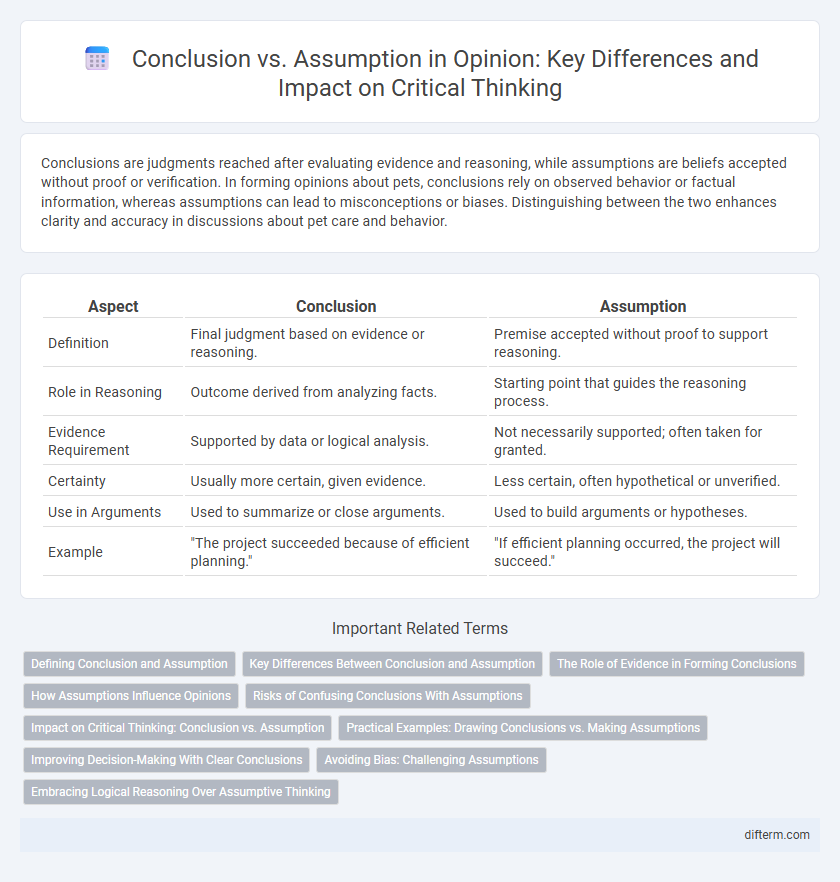Conclusions are judgments reached after evaluating evidence and reasoning, while assumptions are beliefs accepted without proof or verification. In forming opinions about pets, conclusions rely on observed behavior or factual information, whereas assumptions can lead to misconceptions or biases. Distinguishing between the two enhances clarity and accuracy in discussions about pet care and behavior.
Table of Comparison
| Aspect | Conclusion | Assumption |
|---|---|---|
| Definition | Final judgment based on evidence or reasoning. | Premise accepted without proof to support reasoning. |
| Role in Reasoning | Outcome derived from analyzing facts. | Starting point that guides the reasoning process. |
| Evidence Requirement | Supported by data or logical analysis. | Not necessarily supported; often taken for granted. |
| Certainty | Usually more certain, given evidence. | Less certain, often hypothetical or unverified. |
| Use in Arguments | Used to summarize or close arguments. | Used to build arguments or hypotheses. |
| Example | "The project succeeded because of efficient planning." | "If efficient planning occurred, the project will succeed." |
Defining Conclusion and Assumption
A conclusion is the final judgment or decision derived from analyzing evidence and reasoning, representing what is believed to be true based on the given information. An assumption is an underlying, often unstated premise or belief that supports the reasoning process but is not directly proven or verified. Distinguishing between conclusions and assumptions is crucial for critical thinking, as conclusions depend on assumptions to form logical inferences.
Key Differences Between Conclusion and Assumption
A conclusion is a definitive statement derived from evidence and reasoning, while an assumption is a premise taken for granted without proof. Conclusions rely on logical deduction and are supported by facts, whereas assumptions serve as the foundational beliefs that guide reasoning but lack direct validation. Understanding the distinction between conclusion and assumption is critical for effective critical thinking and sound argumentation.
The Role of Evidence in Forming Conclusions
Evidence serves as the foundation for forming valid conclusions, distinguishing them from mere assumptions that lack empirical support. Conclusions emerge from systematically analyzed data and verified facts, ensuring reliability and objectivity in reasoning. Without evidence, assumptions remain speculative opinions rather than well-founded conclusions.
How Assumptions Influence Opinions
Assumptions shape opinions by providing a hidden framework that influences how information is interpreted and conclusions are drawn. When assumptions are inaccurate or biased, they can lead to flawed opinions, as they steer reasoning away from objective evidence. Recognizing and challenging underlying assumptions enhances the accuracy and fairness of personal viewpoints.
Risks of Confusing Conclusions With Assumptions
Confusing conclusions with assumptions risks flawed decision-making by treating unverified beliefs as proven facts. This misunderstanding can lead to erroneous outcomes, affecting strategic planning and risk assessment. Clear differentiation between conclusions based on evidence and assumptions requiring validation is essential to mitigate operational and financial risks.
Impact on Critical Thinking: Conclusion vs. Assumption
Conclusions draw from evaluated evidence, promoting informed decision-making and enhancing critical thinking by solidifying understanding through logical reasoning. Assumptions, often based on incomplete information, can hinder critical thinking by introducing bias and uncertainty, leading to premature judgments. Distinguishing conclusions from assumptions sharpens analytical skills and fosters clearer, more objective evaluations in problem-solving processes.
Practical Examples: Drawing Conclusions vs. Making Assumptions
Drawing conclusions relies on analyzing concrete evidence, such as measurable data from experiments or verified statistics from credible sources. Making assumptions involves forming beliefs without sufficient proof, like presuming someone's intentions without direct communication or basing decisions on stereotypes. Practical examples include concluding a market trend from sales reports versus assuming customer preferences without surveys.
Improving Decision-Making With Clear Conclusions
Clear conclusions enhance decision-making by providing definitive and evidence-based outcomes, reducing ambiguity and speculation. Unlike assumptions, which can introduce bias and uncertainty, conclusions are grounded in thorough analysis and factual data. This clarity empowers individuals and organizations to make informed, confident choices that drive effective results.
Avoiding Bias: Challenging Assumptions
Challenging assumptions is crucial for avoiding bias, as assumptions often limit perspective and reinforce preconceived notions. Drawing conclusions should be based on evidence and critical analysis rather than unexamined beliefs, which reduces the risk of cognitive bias. Rigorous questioning of underlying assumptions promotes more objective and balanced conclusions in opinion formation.
Embracing Logical Reasoning Over Assumptive Thinking
Reliable conclusions stem from evidence-based logical reasoning, which strengthens critical thinking and decision-making processes. Assumptive thinking often leads to biased or unfounded judgments that undermine rational analysis. Embracing a structured approach grounded in verifiable facts enhances clarity and intellectual integrity.
conclusion vs assumption Infographic

 difterm.com
difterm.com